This sectionbv presents the medium-term trends and prospects using the FAO fish model (FAO, 2012, pp. 186–193), developed in 2010 to inform on potential future developments in fisheries and aquaculture. The fish model has links to, but is not integrated into, the Aglink-Cosimo model used annually to generate the ten-year-horizon agricultural projections elaborated jointly by the Organisation for Economic Co-operation and Development (OECD) and FAO and published each year in the OECD-FAO Agricultural Outlook.bw The FAO fish model considers the set of macroeconomic assumptions and selected prices used to generate the agricultural projections, in addition to specific assumptions and data related to the fisheries and aquaculture sectors. An ad hoc analysis was carried out by FAO for the years 2022–2032 to obtain the following fisheries and aquaculture projections.
These projections provide an outlook of the ten-year prospects for fisheries and aquaculture production, utilization, trade and prices, and highlight key issues that might influence future supply and demand of aquatic products. These projections are not forecasts, but plausible scenarios that provide insight into how these sectors may develop in light of a set of macroeconomic, policy and demographic assumptions. These assumptions consider the enhancement of fisheries and aquaculture management, including catch limitations, but do not consider the occurrence of severe events such as tsunamis, tropical storms (cyclones, hurricanes and typhoons), floods, emerging diseases of aquatic species and market shocks. These projections were generated assuming that consumer preferences and technologies will likely continue to develop and that current policies will remain in place, including the continuation of the Chinese policy implemented since 2016 to promote sustainable and environmentally friendly fisheries and aquaculture (FAO, 2018c). Population and economic growth, urbanization, technological developments and dietary diversification are expected to expand the demand for aquatic foods.
Production
World fisheries and aquaculture production of aquatic animals is expected to grow further reaching 205 million tonnes (live weight equivalent) in 2032 (Figure 64), an additional 19 million tonnes or 10 percent increase relative to 2022 (Table 14). Both the rate and absolute level of growth are projected to decline compared with the 22 percent growth (33 million tonnes) during the period 2012–2022. Most of the increase will come from aquaculture, expected to break the 100 million tonnes threshold for the first time in 2027, reaching 111 million tonnes in 2032, with an overall growth of 17 percent or nearly 16 million tonnes compared with 2022.
FIGURE 64World fisheries and aquaculture production of aquatic animals, 1980–2032

SOURCE: FAO estimates.
TABLE 14PROJECTED FISHERIES AND AQUACULTURE PRODUCTION OF AQUATIC ANIMALS TO 2032
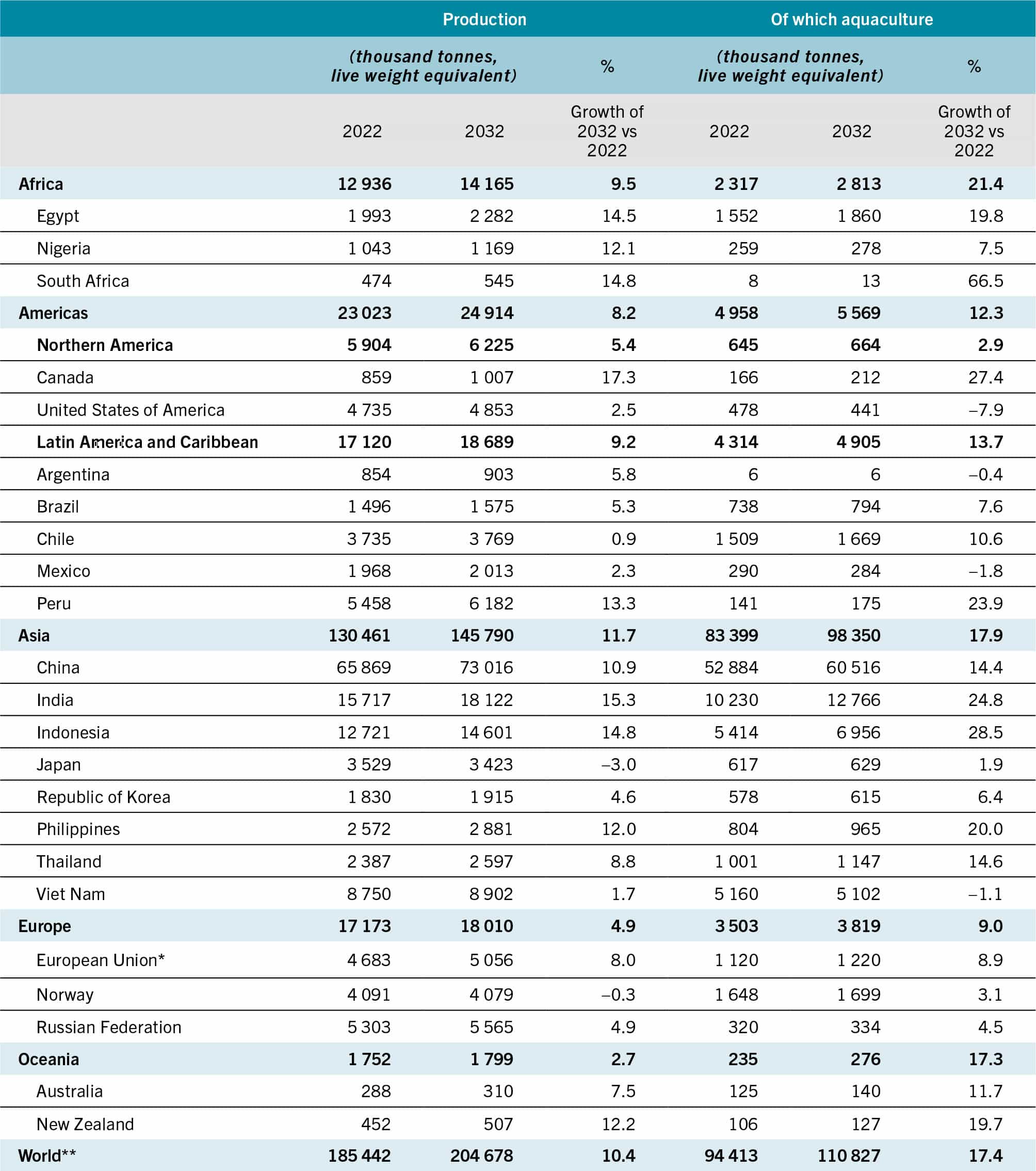
* Cyprus is included in Asia as well as in the European Union but not in Europe.
** For 2022, the aggregate includes also 40 498 tonnes of not identified countries, data not included in any other aggregates.
SOURCE: FAO estimates.
The continuous increase in aquaculture production projected over the period 2022–2032 will occur at an average annual growth rate of 1.6 percent, less than half the 4.0 percent rate observed in 2012–2022 (Figure 65).bx This reduced growth rate will depend on several factors such as wider adoption and enforcement of environmental regulations; reduced availability of water (both quality and quantity) and suitable aquaculture sites; increasing impact of aquatic animal diseases in intensive aquaculture; and reduced productivity gains. Chinese policies are expected to account significantly for the overall reduced growth. Initiated in 2016, these policiesby aim to continue integrating environmental considerations in aquaculture production to improve its sustainability by promoting the adoption of ecologically sound technological innovations and water recycling; not extending the areas dedicated to aquaculture; and reducing the use of antibiotics in production. All these actions will cause an initial capacity reduction, followed by faster growth. Despite these changes, China will remain the world’s leading aquaculture producer, with an expected increase of 14 percent (or about 8 million tonnes) by 2032, nearly half the increase in 2012–2022 (15 million tonnes or 39 percent). China’s contribution to world aquaculture production in 2032 is projected to reach 55 percent (compared with 56 percent in 2022). It will however contribute 83 percent of total Chinese fisheries and aquaculture production, increasing from 80 percent in 2022. The resource rent tax on salmon and trout farming introduced by Norway in 2023 can decrease the farming profitability of these species and affect their future production, Norway being the largest producer in the world of Atlantic salmon. The decadal projection assumes that the tax is eliminated in 2026, with Norway increasing its aquaculture output by 7 percent up to 2032. If the tax is kept, Norwegian aquaculture production would decrease by about 9 percent by 2032.
FIGURE 65ANNUAL GROWTH OF WORLD AQUACULTURE PRODUCTION BY VOLUME, 1980–2032
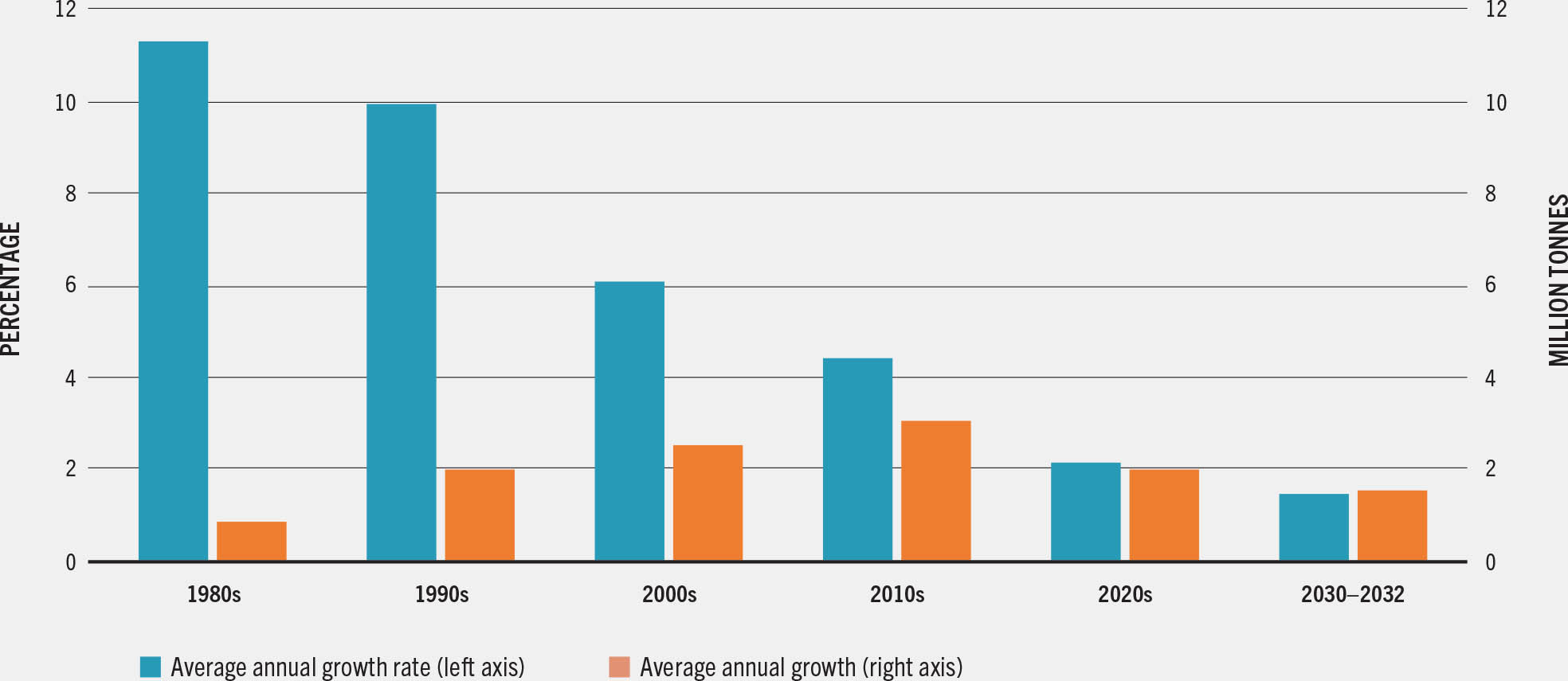
SOURCE: FAO estimates.
The projected deceleration of China’s aquaculture production will be partially compensated for by a production increase in other countries. Growth of aquaculture production is projected for all continents, except a 1 percent decline in Europe, with variations in the range of species and products across countries and regions. By 2032, the sector is projected to expand most in Africa (up 21 percent from 2022), Asia (up 18 percent), Oceania (up 17 percent) and Latin America and Caribbean (up 14 percent). Aquaculture growth in Africa will result from the additional farming capacity installed in recent years, following national policies promoting aquaculture and the rising local demand. However, this projected growth of aquaculture production in Africa will remain limited, slightly over 2.8 million tonnes in 2032, with the bulk (1.9 million tonnes) produced by Egypt. Asian countries should continue to dominate the aquaculture sector in 2032, producing 89 percent of the world output of aquatic animals (up from 88 percent in 2022) and generating more than 91 percent of the increase in production by 2032.
The share of farmed species in global fisheries and aquaculture production of aquatic animals is projected to grow from 51 percent in 2022 to 54 percent in 2032 (Figure 66). Excluding China, the world share will grow from 35 percent in 2022 to 38 percent in 2032. The role of aquaculture in total fisheries and aquaculture production will increase in all continents, except Northern America where it will remain around 11 percent, the lowest share among all major regions. In 2032, these shares will reach 15 percent in Oceania (up from 13 percent in 2022), 22 percent in Africa (up from 18 percent), 21 percent in Europe (up from 20 percent), 26 percent in Latin America and the Caribbean (up from 25 percent) and 67 percent in Asia (up from 64 percent) – but excluding China, growth in Asia will increase from 47 percent to 52 percent (Figure 67).
FIGURE 66Increasing role of aquaculture
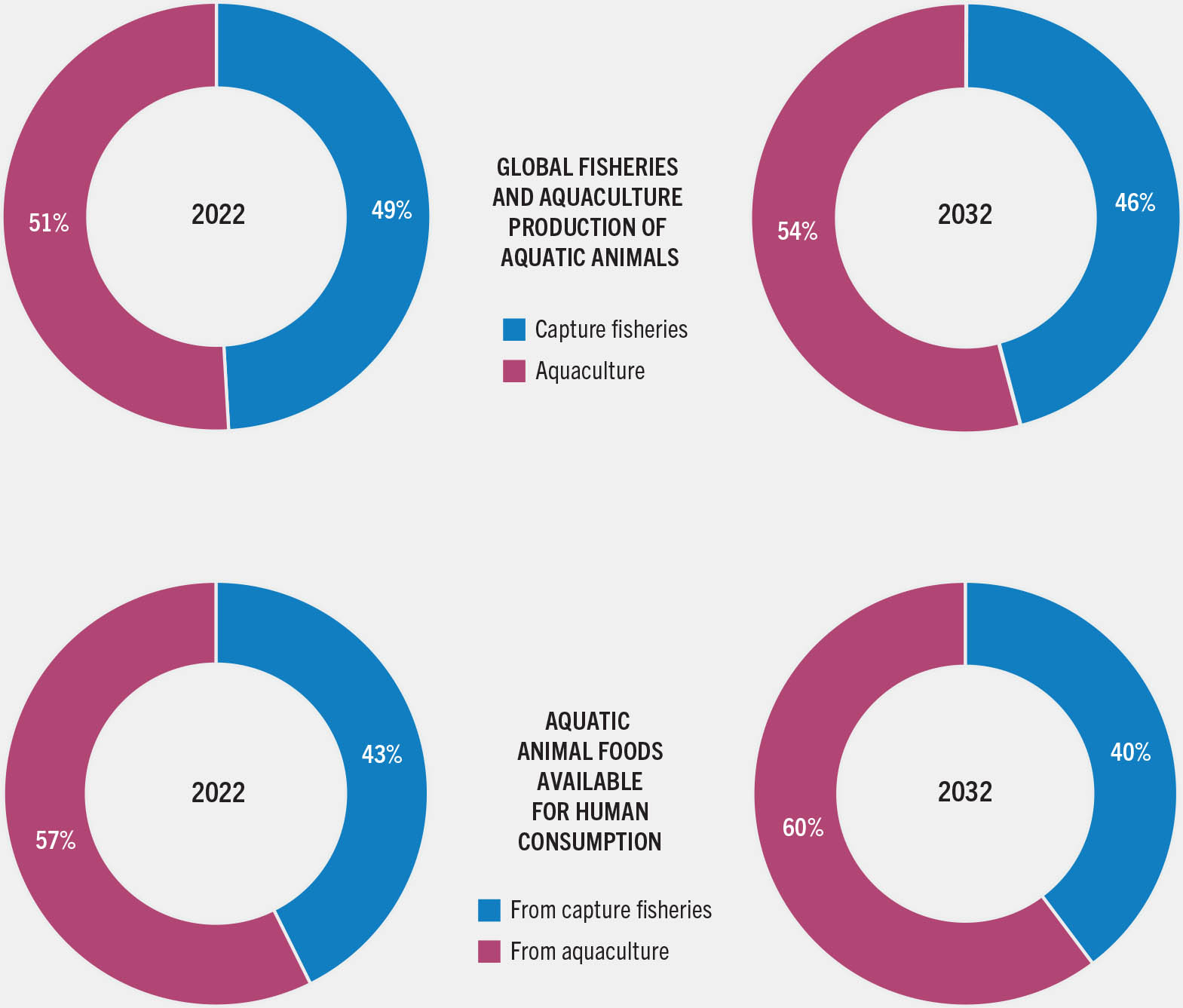
SOURCE: FAO estimates.
FIGURE 67SHARE OF AQUACULTURE IN total fisheries and aquaculture production of aquatic animals by region AND VOLUME, 2022 VS 2032

SOURCE: FAO estimates.
Production of all major groups of farmed species will continue to increase, but at uneven rates of growth across groups, consequently modifying the importance of different species. In general, species needing large proportions of fishmeal and fish oil in their diets are projected to grow more slowly owing to expected higher prices and reduced availability of fishmeal. Carp is likely to remain the main group of species produced in 2032, but with a declining share in the total production volume. Taxation in Norway will likely reduce slightly the share of salmonoids in total production.
Capture fisheries is projected to increase by 3 million tonnes to reach about 94 million tonnes in 2032, with an overall increase of 3 percent from 2022.bz Some fluctuations are expected in selected years of the next decade linked to the El Niño phenomenon that will reduce catches in South America, especially for anchoveta, with a resulting decrease in world capture fisheries production of about 2 percent in those years. The overall increase in capture fisheries production by 2032 is expected to be driven by different factors, including (i) increased catches in some fishing areas where stocks of certain species are recovering owing to improved resource management; (ii) growth in catches in waters of the few countries with underfished resources, where new fishing opportunities exist or where fisheries management measures are less restrictive, including for species not subject to strict production quotas; (iii) technological improvements; and (iv) reduced discards and bycatch, enforced by changes in legislation or higher market prices (including for fishmeal and fish oil). Similarly to aquaculture, China will remain the major producer of capture fisheries. Yet, its overall production should decline by 4 percent by 2032, as it continues implementing its environmental policies into the next decade, reducing domestic catches through enforcement of controls on licensing, reduction in the number of fishers and fishing vessels, and implementation of output controls. Other measures include modernization of gear, vessels and infrastructure; regular reduction of fuel subsidies; elimination of illegal, unreported and unregulated fishing (IUU fishing); and restoration of domestic fishery stocks through restocking, artificial reefs and seasonal closures. However, the projected decline in domestic catches is expected to be compensated for by an increase in distant-water fleet catches.
By 2032, production of both fishmeal and fish oil is projected to increase by, respectively, 9 percent and 12 percent compared with 2022, but the share of capture fisheries production reduced into fishmeal and fish oil should remain stable at around 19 percent. These increases in fishmeal and fish oil production will use whole fish resulting from the growth in capture fisheries production in 2032 compared with 2022, combined with by-products (see Products: fishmeal and fish oil, p. 68) of the processing industry (Figure 68). Between 2022 and 2032, the proportion of total fishmeal obtained from fish by-products is projected to increase from 27 percent to 30 percent, while the proportion of total fish oil is projected to remain stable at about 57 percent. Peru and Chile will continue to be the top producers of, respectively, fishmeal and fish oil.
FIGURE 68World fishmeal production, 1990–2032
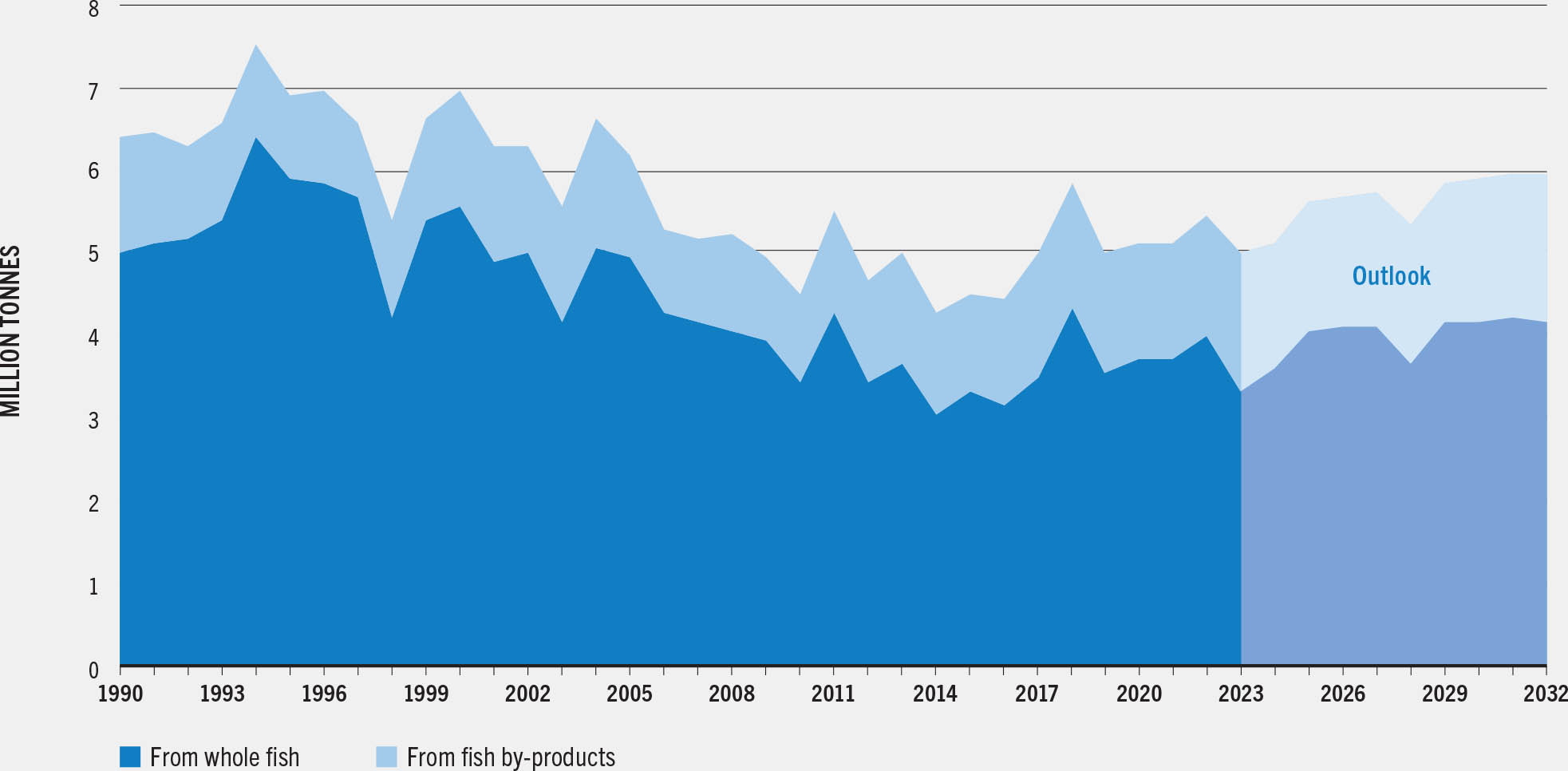
SOURCE: FAO estimates.
Apparent consumption of aquatic foods
Food remains the primary use for aquatic production, with most fisheries and aquaculture production of aquatic animals destined for human consumption.ca This share will grow from 89 percent in 2022 to 90 percent by 2032. Overall, by 2032, aquatic foods for human consumption are projected to increase by 19 million tonnes compared with 2022, reaching 184 million tonnes, but expanding less rapidly than over the previous decade. This represents an overall increase of about 12 percent, compared with 24 percent in 2012–2022. This slowdown mainly reflects the reduction in availability of additional fisheries and aquaculture production, higher prices of aquatic foods in nominal terms, a deceleration in population growth, and saturated demand in some countries, particularly high-income countries, where aquatic food consumption is projected to show little growth. In 2032, about 60 percent of the aquatic foods available for human consumption are expected to originate from aquaculture production, up from 57 percent in 2022 (Figure 66).
Trends in consumption will differ between countries and regions due to different dynamics in population, income, consumer preferences, and rapid urbanization in many emerging economies. In low-income countries where food represents a high share of household expenditure, changes in income and food prices will have a larger impact on consumption than in high-income countries. Demand will also be stimulated by changes in dietary trends, with more variety of foods consumed, and a greater focus on better health, nutrition and diet, with aquatic food playing a key role in this regard. Overall, growth in demand of aquatic foods will stem mostly from Asian countries, which are expected to account for 78 percent of the increase in consumption by 2032, consuming 73 percent of the aquatic foods available in 2032 (compared with 72 percent in 2022). Between 2022 and 2032, total apparent consumption of aquatic food is expected to increase in all regions, except in Europe, with higher growth rates projected in Africa (23 percent), Asia (13 percent), Latin America and the Caribbean (10 percent), Oceania (9 percent) and Northern America (8 percent). Despite these regional trends, the overall tendencies in quantity and variety of aquatic foods consumed will vary among and within countries.
Per capita apparent consumption of aquatic animal foods is projected to reach 21.3 kg in 2032, up from about 20.7 kg in 2022. It will increase in all regions except Africa and Europe. In Africa – which in 2019–2022 experienced a decline in per capita consumption (from 9.9 kg to 9.4 kg) due to the effects of the COVID-19 pandemic – the expected increase in total supply of aquatic foods up to 2032 will not be sufficient to compensate for population growth, projected at over 25 percent between 2022 and 2032. The decline will be mainly in sub-Saharan Africa, while in Northern Africa per capita consumption will marginally increase. In fact, one of the few exceptions will be Egypt, which is expected to expand its aquaculture production by 21 percent between 2022 and 2032. This projected decline in per capita consumption of aquatic foods in Africa, in particular in sub-Saharan Africa, raises food security concerns because of the region’s high prevalence of undernourishment and the importance of aquatic proteins in total animal protein intake in many African countries (see Apparent consumption of aquatic foods, p. 214). The decline weakens the ability of countries that are more dependent on aquatic products to meet the nutrition targets (2.1 and 2.2) of SDG 2 (End hunger, achieve food security and improved nutrition and promote sustainable agriculture). This trend can only be modified through a substantial increase in the aquatic food supply to be obtained through increased production and imports (Box 48).
BOX 48Meeting the challenge of rising population: implications for SUPPLY OF AQUATIC ANIMAL FOODS
The world population is projected to reach 9.7 billion by 2050, up by 1.7 billion compared with 2022. This will have significant implications for the supply of aquatic animal foods. To maintain through to 2050 per capita apparent consumption of aquatic animal foods at the 2022 estimated level of 20.7 kg would require an increase in the total supply of aquatic animal foods of 36 million tonnes (live weight equivalent), representing a 22 percent rise. Asia would require the largest increase – 14 million tonnes, that is a 12 percent rise – followed by Africa (10 million tonnes, +74 percent), Northern America (1.0 million tonnes, +12 percent), Latin America and the Caribbean (0.9 million tonnes, +13 percent) and Oceania (0.3 million tonnes, +28 percent). On the other hand, in Europe, where the population is projected to decline by 2050, the supply of aquatic animal foods required to sustain per capita consumption at the same level would be 0.9 million tonnes lower (−5 percent).
On the worldwide scale, meeting the demand for greater availability of aquatic animal foods necessitates higher production. Depending on the region, the required increase in supply may be sourced from increased domestic production, supplemented by imports as and where needed – and when possible. For example, in Africa achieving through domestic production alone the 74 percent increase in supply of aquatic animal foods required to maintain current per capita levels is a major challenge. It requires major investments and transformation of the sector, which is unlikely to occur over a short time based on historical and recent trends. A more likely scenario is that Africa would import from other regions, assuming additional supply is available and affordable. Failure to access this supplementary supply would pose a risk for the region of declining per capita consumption levels, which are already significantly lower than the world average, despite the key role of aquatic nutrients in many African countries.
REQUIRED GROWTH IN SUPPLY OF AQUATIC ANIMAL FOODS TO SUSTAIN 2022 PER CAPITA CONSUMPTION LEVELS THROUGH TO 2050
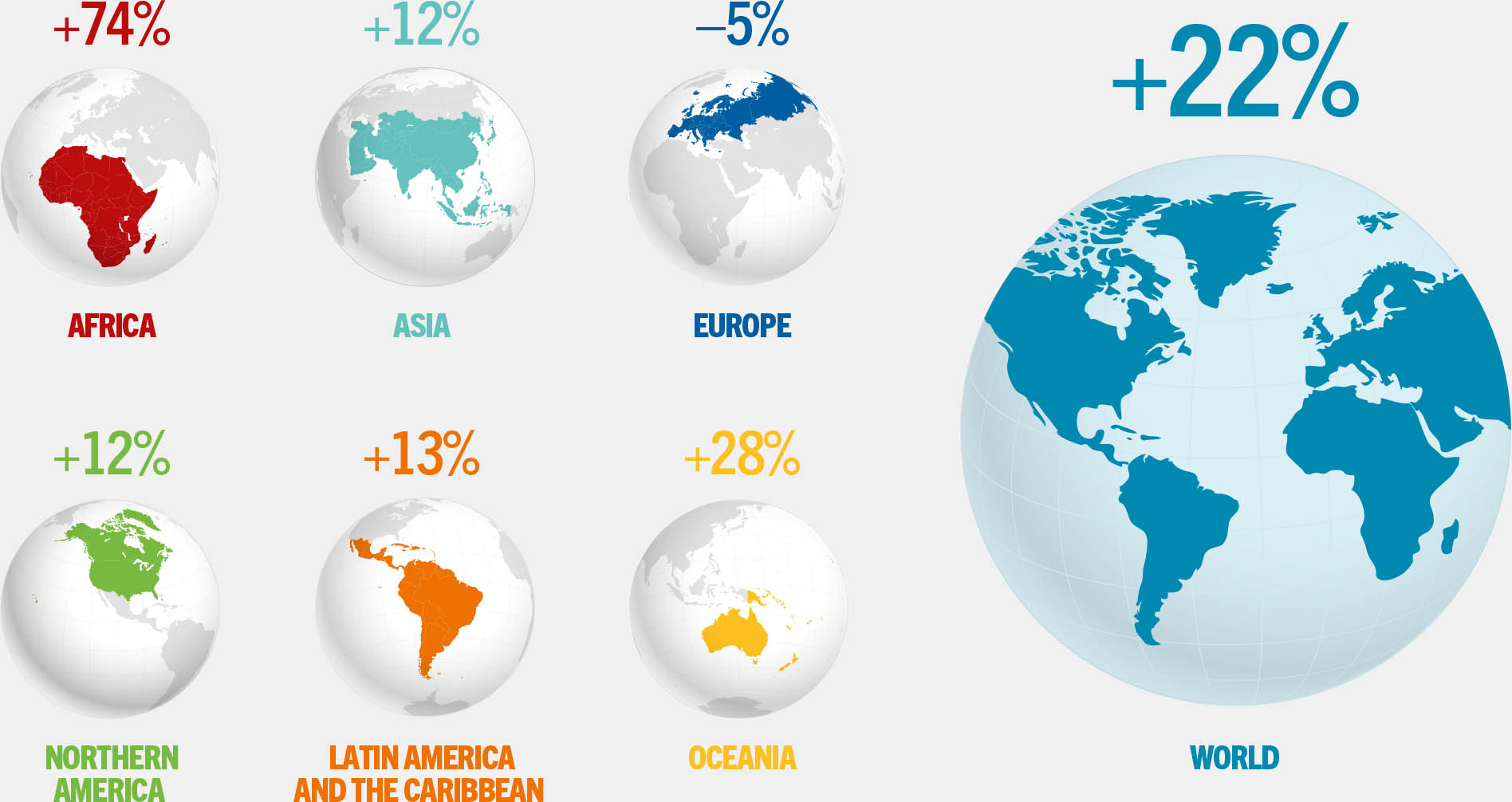
Such a substantial increase in Africa’s supply of aquatic animal foods would nevertheless barely maintain the current level of consumption of aquatic animal foods per capita, which is still much lower than that in other regions. To raise African per capita annual consumption from the current 9.4 kg to the 2022 world average of 20.7 kg, supply of aquatic animal foods in Africa would need to increase by about 38 million tonnes or +285 percent.
Each region will encounter unique needs and challenges based on population growth projections. Strategic planning is essential to ensure that food supply aligns with demand, involving expansions in aquaculture, enhancements in fishing practices, investments in sustainable resource management, and the upgrading of aquatic value chains.
These data consider only population growth, with no changes in the amount for non-food uses, which are expected to remain at current levels. This analysis does not predict the future but provides an indication of the requirements for maintaining the status quo in world consumption of aquatic animal foods per capita.
Cognizant of these challenges, FAO launched the Blue Transformation Roadmap in 2021 (FAO, 2022) to support expansion and intensification of aquaculture, putting world fisheries under effective management and optimizing aquatic food value chains to reduce loss and waste and add value.
Trade
Trade of aquatic products will continue to enhance the role of fisheries and aquaculture for economic development, world food supply and food security. The expansion of trade in aquatic products will continue over the outlook period, bolstered by improvements in post-harvest technology and distribution channels that will support the expansion of the commercialization of aquatic products. Yet, trade of aquatic products is expected to grow at a slower pace (in volume) than in the previous decade, reflecting the slowdown in production growth, higher fisheries and aquaculture prices (which will restrain overall demand and consumption of aquatic species), and stronger domestic demand in some of the major producing and exporting countries such as China. As a result, the share of aquatic products exported over the total fisheries and aquaculture production will decline from 38 percent in 2022 to 34 percent in 2032 (30 percent, excluding intra-European Union trade). In quantity terms, the bulk of the growth in exports of aquatic foods will continue to originate from Asia, which will account for about 44 percent of the additional exported volume by 2032. Asia’s share in total exports of aquatic products for human consumption will remain stable at about 50 percent in 2032 (Figure 69). In quantity terms, China will continue to be the major exporter of aquatic foods, followed by Viet Nam and Norway. The European Union, the United States of America, China and Japan will be the main importers, absorbing 50 percent of total imports for aquatic food consumption in 2032, compared with 52 percent in 2022.
FIGURE 69EXPORTS AND IMPORTS OF AQUATIC ANIMAL FOODS BY REGION AND VOLUME
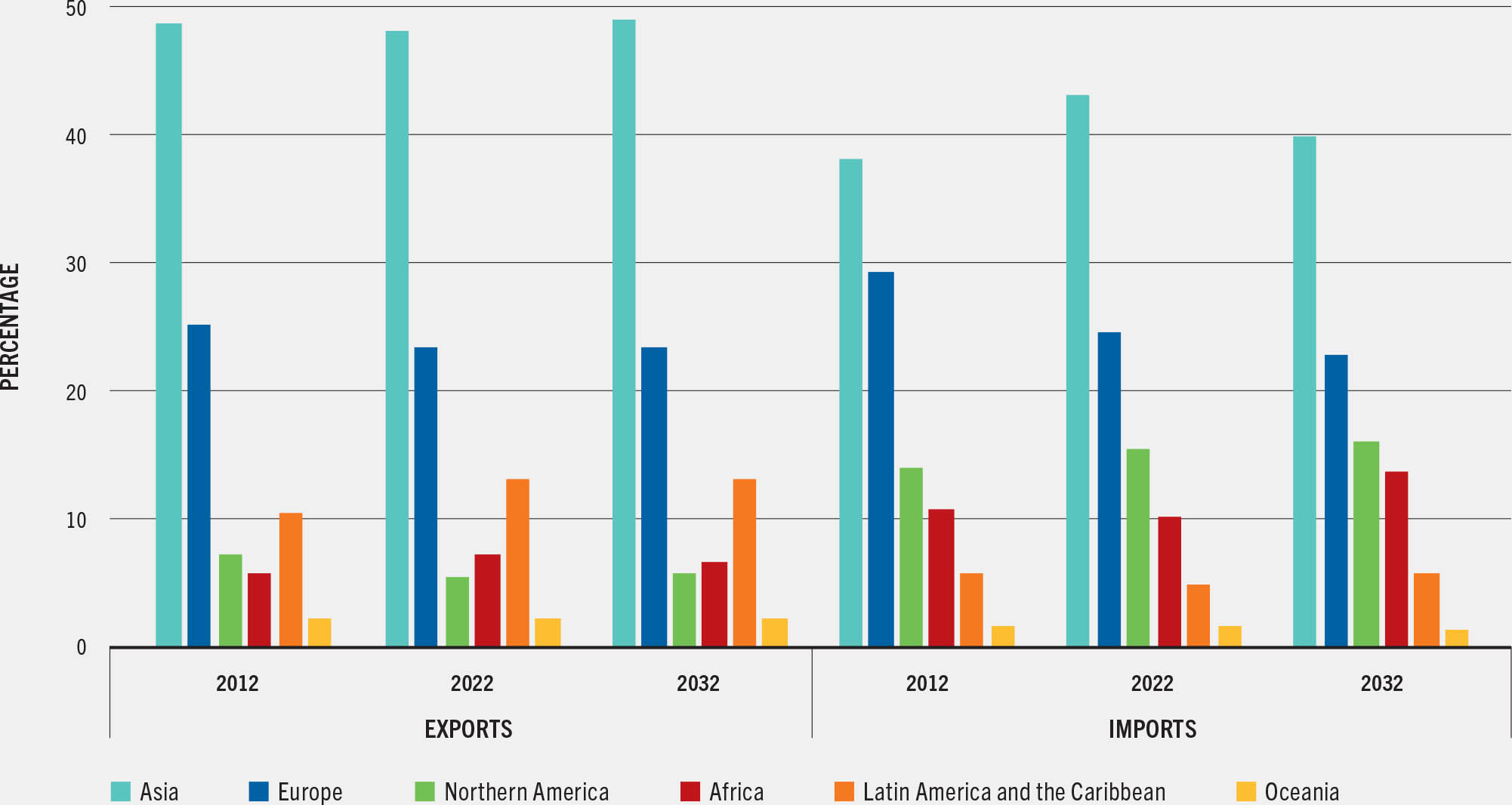
SOURCE: FAO estimates.
Trade of fishmeal and fish oil is expected to increase by 4 percent and 11 percent respectively. Peru and Chile will continue to be the main exporters of fish oil, and Norway and the European Union the main importers, in particular for aquaculture production of salmonoids. Peru is also expected to remain the leading exporter of fishmeal, followed by the European Union and Chile, with China the major importer.
Prices
After soaring in 2022, fisheries and aquaculture prices declined in 2023 and are expected to continue falling slightly in both nominal and real terms until 2025–2027, before then increasing. Overall, prices are expected to grow moderately in nominal terms from 2022 to 2032, driven on the demand side by improved income, population growth and higher meat prices, and on the supply side by marginal increase in capture fisheries production, slower growth in aquaculture production and cost pressure from crucial inputs such as feed, energy and fish oil. With a growth of 7 percent, the average price of aquaculture products will rise more than that of captured products (when excluding aquatic products for non-food uses), which will grow by 5 percent. Prices of farmed aquatic species will also increase owing to higher fishmeal and fish oil prices, both of which are expected to rise by 12 percent by 2032. High feed prices could also influence the composition of farmed species, shifting towards species requiring less feed, cheaper feed or no feed at all. The higher prices at the production level, coupled with high demand for aquatic foods, will stimulate an estimated 5 percent growth in the average price of internationally traded aquatic products by 2032 relative to 2022.
In real terms, it is assumed that all prices will decline over the projection period, while remaining relatively high. For individual aquatic products, price volatility could be more pronounced due to fluctuations in supply or demand. Moreover, because aquaculture is expected to represent a higher share of world fisheries and aquaculture supply, it could have a stronger impact on price formation in national and international markets of aquatic products. Major decreases are expected for capture fisheries (excluding non-food uses) and traded products (each declining by 16 percent), as well as for aquaculture (15 percent). Average prices of fish oil and fishmeal are projected to decrease by, respectively, 11 percent and 10 percent. However, since both prices have been at historically high levels, by 2032 fishmeal prices will still be 33 percent higher than in 2005, when major price increases began. This situation is even more pronounced for fish oil, where the real price in 2032 is expected to be over 160 percent higher than in 2005. Considered together, and all else remaining equal, this suggests that converting capture fisheries and fish waste to fishmeal and fish oil will remain a lucrative activity over the period projected.
Summary of main outcomes from the projections
The following major trends for the period to 2032 emerge from the analysis:
- World fisheries and aquaculture production, consumption and trade are expected to increase, but growth rates will slow over time.
- Overall production should increase by 10 percent, reaching 205 million tonnes by 2032.
- With an increase in aquaculture production of 17 percent compared with a growth in capture fisheries of 4 percent, aquaculture is anticipated to fill most of the supply–demand gap.
- Trends in capture fisheries production are expected to remain similar to those in the past few decades, with moderate growth projected in overall output, mainly in areas where resources are properly managed.
- Aquatic food supply will increase in all regions, except Europe, while per capita consumption is expected to decline slightly in Europe and Africa, in particular in sub-Saharan Africa, raising concerns about food security.
- Trade in aquatic products is expected to increase more slowly than in the past decade, with a decline in the share of world fisheries and aquaculture production that is exported.
- While prices will all increase in nominal terms, they are all expected to decline in real terms.
Main uncertainties
The projections presented in this section rely on a series of economic, policy and environmental assumptions. A deviation of any of these assumptions would result in different fisheries and aquaculture projections. In the short term, major levels of uncertainty are linked to the overall economic and geopolitical situation, including recent conflicts, major changes in the aquatic environment, availability of resources, macroeconomic conditions, international trade rules and tariffs, and market characteristics. These aspects may affect production, markets and trade in the medium term. Whether the World Trade Organization negotiations on fisheries subsidies succeed can have an impact on capture fisheries production. In addition, market access requirements related to food safety, quality, sustainability, and traceability and product legality will continue to regulate international trade of fisheries and aquaculture products.
Climate variability and change, including in the frequency and extent of extreme weather events, are expected to have significant and geographically differential impacts on the availability, processing and trade of aquatic products, making countries more vulnerable to risks. These risks can be exacerbated by: (i) poor governance causing environmental degradation and habitat destruction (leading to pressure on the resource bases), overfishing, IUU fishing, diseases and invasions by escapees and non-native species; and (ii) aquaculture issues associated with the accessibility and availability of suitable sites and water resources and access to credit, seed and expertise. These risks can be mitigated through responsive and effective governance promoting stringent fisheries management regimes, responsible aquaculture growth and improvements in technology, innovations and research. In the long term, the implementation of these improvements and of proper management policies can have very positive impacts on total fisheries and aquaculture production, as illustrated in the high-road scenario developed by FAO to 2050 (FAO, 2022a). FAO Blue Transformation and its Roadmap provide pathways for progressive and effective management of living aquatic resources that reconcile food security and poverty alleviation with environmental sustainability.
- bv In Fisheries and aquaculture projections, 2022–2032, the statistical analysis on production, utilization, consumption and trade only covers aquatic animals (excluding aquatic mammals and reptiles). Detailed coverage of species is indicated in the Glossary.
- bw For more information about the OECD-FAO Agricultural Outlook and the work on the models see: https://www.agri-outlook.org/
- bx It is important to note that a reduction in growth rate does not indicate a decrease in production. Expressed in percentage terms, growth rates are usually higher when the calculation starts from a low base, and they decline as the size of the base grows.
- by Thirteenth (2016–2020) and Fourteenth (2021–2025) Five-Year Plans.
- bz The projections assume normal weather and production conditions, with the exception of the impact of the El Niño phenomenon set for selected Latin American countries to occur more strongly every five years, based on more recent trends. The years in which it occurs might not be exact, but the trends provide an indication as to the possible overall effects on both capture fisheries production and aquaculture. This climatic phenomenon reduces production of fishmeal and fish oil obtained from anchoveta and other small pelagic species in the affected region, with an impact on prices and input costs for aquaculture. It is important to note that a reduction in growth rate does not indicate a decrease in production. Expressed in percentage terms, growth rates are usually higher when the calculation starts from a low base, and these rates decline as the size of the base grows.
- ca As in Apparent consumption of aquatic foods (p. 73), consumption is expressed in live weight equivalent and refers to the apparent aquatic food consumption.

